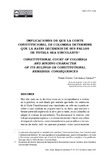| dc.rights.licence | Atribución-NoComercial-SinDerivadas 4.0 Internacional | * |
| dc.contributor.author | Contreras Jordan, Pedro Daniel | |
| dc.date.accessioned | 2019-07-12T20:44:25Z | |
| dc.date.accessioned | 2020-04-15T13:41:39Z | |
| dc.date.available | 2019-07-12T20:44:25Z | |
| dc.date.available | 2020-04-15T13:41:39Z | |
| dc.date.created | 2019 | |
| dc.identifier.issn | 1794-5216 | spa |
| dc.identifier.uri | http://hdl.handle.net/10554/43801 | |
| dc.description.abstract | Hoy día, tanto en la doctrina como en la jurisprudencia e incluso en la práctica, se está dando por sentado que todas las sentencias de la Corte Constitucional son vinculantes no solo en su parte resolutiva sino también en su parte motiva, es decir, que entraron a formar parte del imperio de la ley y, por lo tanto, ya en Colombia se adoptó el sistema de precedentes. Sin desconocer lo anterior, este trabajo se propone regresar a la discusión inicial y hacer una crítica al origen de esta teoría, concretamente en lo que se refiere a las sentencias de tutela, toda vez que esto presenta varios inconvenientes teóricos que pueden llegar a tener graves repercusiones en el sistema de fuentes, la separación de poderes y la autonomía judicial. | spa |
| dc.rights.uri | http://creativecommons.org/licenses/by-nc-nd/4.0/ | * |
| dc.source | Universitas Estudiantes, No. 19 (enero-junio 2019) | |
| dc.subject | Precedente | spa |
| dc.subject | Tutela | spa |
| dc.subject | Corte Constitucional | spa |
| dc.subject | Ratio decidendi | spa |
| dc.subject | Erga omnes | spa |
| dc.title | Implicaciones de que la Corte Constitucional de Colombia determine que la ratio decidendi de sus fallos de tutela sea vinculante | spa |
| dc.title.alternative | Constitutional Court of Colombia and binding character of its rulings on constitutional remedies : consequences | spa |
| dc.type | info:eu-repo/semantics/article | |
| dc.type.hasversion | http://purl.org/coar/version/c_ab4af688f83e57aa | |
| dc.subject.keyword | Precedent | spa |
| dc.subject.keyword | Action of protection | spa |
| dc.subject.keyword | Constitutional Court | spa |
| dc.subject.keyword | Ratio decidendi | spa |
| dc.subject.keyword | Erga omnes | spa |
| dc.description.abstractenglish | Today, both in the doctrine and in the case law and even in practice, we assume that all the judgments of the Constitutional Court are binding not only in its operative part but in its motivation, that is to say, that they are part of the rule of law and, therefore, already in Colombia the system of precedents was adopted. Without ignoring the above, this work intends to return to the initial discussion and make a critique of the origin of this theory, specifically to what refers to the sentences of action of protection of fundamental rights, because that presents several theoretical problems that can have repercussions on the system of sources, the division of powers and judicial autonomy. For this purpose, the article reviews indispensable jurisprudential and doctrinal sources for a correct understanding of the problem. | spa |
| dc.type.local | Artículo de revista | spa |


